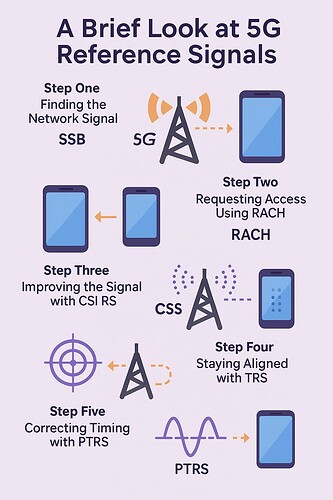When a phone or device connects to a 5G network, it follows a smart process to find and keep the best signal. This ensures fast and reliable service, even while moving or using high speed apps. Let us walk through how this works in a clear and simple way.
Step One: Finding the Network Signal
-
Your device starts by listening for Synchronization Signal Blocks, known as SSB. These signals are sent out from the 5G base station in several directions. The purpose is to help your device detect the presence of the network and figure out where the signal is strongest. SSB also provides timing and frequency information so the phone can sync with the network.
- This part of the process is explained in the 3GPP technical document TS 38.211.
Step Two: Requesting Access Using RACH
-
Once the device finds a good SSB direction, it needs to ask for permission to connect. It does this using the Random Access Channel, or RACH. Through RACH, which is associated to the selected SSB beam, the device sends a short signal to let the network know it wants to start communication. The network responds with timing details and resources to begin the connection properly.
- Beam based RACH is covered in 3GPP TS 38.213 and TS 38.321.
Step Three: Improving the Signal with CSI RS
-
After the connection begins, the network wants to make the signal even better. This is done using Channel State Information Reference Signals, or CSI RS. These are narrow and focused signals that help the network understand how well the signal is reaching your device. Based on this, the network adjusts its direction to improve speed and strength.
- CSI RS details are found in 3GPP TS 38.214.
Step Four: Staying Aligned with TRS
-
When the device moves, the signal can shift. That is why the network uses Tracking Reference Signals, called TRS. TRS helps monitor motion and adjust the beam so the connection stays steady. This is important for mobile users, such as when someone is walking or driving while connected.
- TRS use is described in TS 38.211 and TS 38.214.
Step Five: Correcting Timing with PTRS
-
For very precise communication, especially at higher frequencies, small timing errors can happen. Phase Tracking Reference Signals, or PTRS, help correct those errors. They keep the signal clear and stable, which is essential for tasks like online gaming or Virtual Reality or video calls.
- PTRS functions are found in 3GPP TS 38.211 and TS 38.212.
Summary
This teamwork of signals helps devices stay connected. SSB helps discover the network, RACH starts the conversation, CSI RS improves the signal, TRS tracks movement, and PTRS keeps timing in check. These steps give us fast downloads, smooth video calls, and reliable streaming.
5G does more than just send a signal. It works through smart stages to make sure your connection is strong and stable. Based on 3GPP Release 15 and 16 standards and beyond, this technology keeps your device performing well wherever you are.
LinkedIn: ![]()
